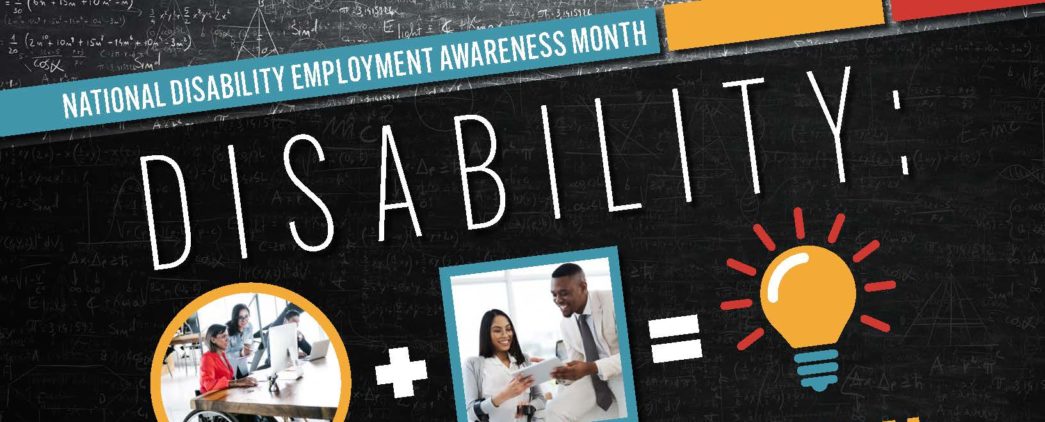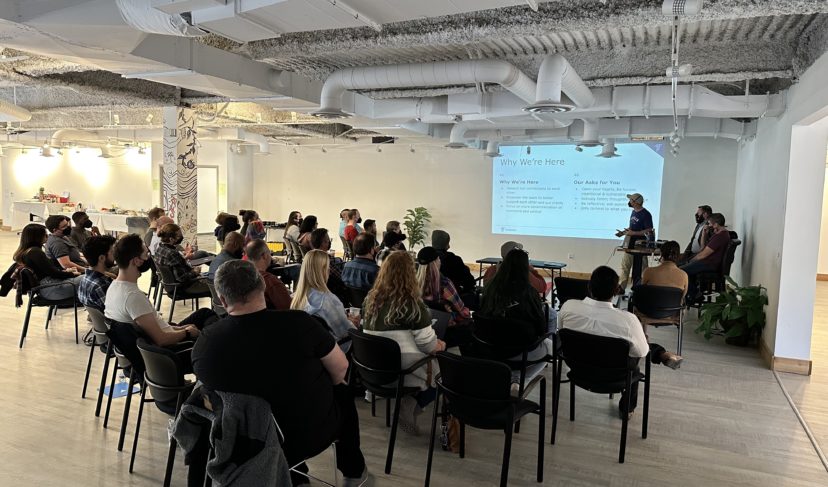National Disabilities Employment Awareness Month (NDEAM)
Investing in inclusive and accessible workplaces benefits everyone, including businesses

October is National Disabilities Employment Awareness Month or NDEAM. The theme for this year’s awareness month is that disability is a part of the Diversity, Equity, and Inclusion (DE&I) conversation.
Disability defined
Before we dive too far into some of the current statistics about disability and employment, let’s first define how the government identifies persons with a disability. Using the monthly Current Population Survey (CPS), the Bureau of Labor Statistics (BLS) conducts monthly surveys of 60,000 households across a range of topics. People classified as having a disability have answered, ‘yes’ to any of the following six questions:
- Is anyone deaf or does anyone have serious difficulty hearing?
- Is anyone blind or does anyone have serious difficulty seeing even when wearing glasses?
- Because of a physical, mental, or emotional condition, does anyone have serious difficulty concentrating, remembering, or making decisions?
- Does anyone have serious difficulty walking or climbing stairs?
- Does anyone have difficulty dressing or bathing?
- Because of a physical, mental, or emotional condition, does anyone have difficulty doing errands alone such as visiting a doctor’s office or shopping?
There are aspects of these questions that we like because most of the broad statistics that are bantered about drastically underestimate the number of people who have a disability. For example, we appreciate that the BLS is including mental and emotional health as part of their identification. We would also be remiss if we didn’t recognize the importance of their transparency in defining, tracking, and publishing this information.
However, they are underreporting the number of people with a disability by not having a question(s) that clearly identifies people who may have a temporary or episodic disability. Because they couch their questions in the form of being able to complete everyday tasks such as bathing or shopping, this may not apply to people with temporary or episodic conditions that allow them to complete such tasks, but could also keep them from the employment they want. Suffice it to say this measurement still relies on self-identification or reporting which likely leads to underreporting.
Note for digital accessibility-specific readers: Tamman includes people who have a situational use constraint as an additional disabilities category as they would see a benefit from digital accessibility improvements on the web. However, for purposes of employment statistics, that category does not fully apply.
The statistics
According to the Department of Labor, the Labor Force Participation Rate for:
- People with disabilities: 23.2%
- People without disabilities: 67.8%
The Unemployment Rate
- People with disabilities: 7.3%
- People without disabilities: 3.1%
“There are three types of lies — lies, damn lies, and statistics.” ― Benjamin Disraeli
The statistics around unemployment of people with disabilities fluctuates monthly as it does for those classified as not having a disability. 7.3% seems high, but not emergency-level high. This does not tell the whole story of the employment of people with disabilities. This 7.3% does not represent all the people who have stopped looking. It does not represent all the underemployed people. The more accurate statistic that is buried on page three of the most recent BLS News Release. It states, “Persons who are neither employed nor unemployed are not in the labor force. A large proportion of persons with a disability—about 8 in 10—were not in the labor force in 2021, compared with about 3 in 10 of those with no disability.”
While inclusive of persons over the age of 65, this is a statement that provides us with an understandable number. And it is this number that keeps us up at night – 8 in 10 people with a disability are not in the American workforce. If this were the case for any other group, it would be a national emergency. People with disabilities make up the largest minority group in the U.S. and yet, month over month, year over year, we seem to be okay with the fact that this level of talent, skills, and expertise is just sitting on the sidelines of our economy! If we can begin to affect this statistic, then it will have dramatic effects on the people and the businesses that employ them.
Taking action
There are so many underlying issues related to why people are not involved in the workforce and they are as specific and individualized as people themselves. What is clear is that systemic issues start at the very foundations of the labor market. While many businesses are (slowly) waking up to the importance of building digital accessibility into their consumer-facing products and services either because of an economic realization that they should not exclude a large customer base or through a demand letter/the very real fear of litigation. This is happening thanks to the tireless efforts of many advocates and awareness building the message is being heard more and more. Unfortunately, there is a distinct lack of advocacy for employers to focus that same user experience and digital accessibility energy on their workforce.
“If disabled workers experienced the same employment rate as those without a disability, nearly 14 million more disabled people would have been employed in 2021.”
Center for American Progress
For disabled workers, even finding or applying for jobs is a process of overcoming inaccessible websites and job boards. Then, the whole application and interview process is riddled with frustration and dismissals. Employers still fully discriminate against people with visible disabilities out of their very real fear of not being able to properly support these individuals. They are assuming failure before taking the chance. Yet, many have not taken the next step of examining and improving their systems to change that fact. There is a real incentive for employers to take action too. From ensuring their job application and interview process is accessible to accessible PDFs and physical accommodations, employers of all sizes have not been awakened to the fact that there is a vast untapped talent pool waiting to be engaged. According to the Center for American Progress, “If disabled workers experienced the same employment rate as those without a disability, nearly 14 million more disabled people would have been employed in 2021.” This effort takes intention, but that intention has a huge payoff, especially in a labor market that is at a 50-year low in terms of unemployment.
Employers need guidance and support to assess their tools to ensure they are accessible. Large companies that are increasingly investing in their DE&I departments, should take the lead on this endeavor. By working with subject matter experts like Tamman, and taking the time to make internal processes and tools more accessible, they will also find as has happened with consumers and electronics that people with and without disabilities reap the benefits. For example, one does not need a specific use constraint to use and appreciate captions. Accessibility is necessary for some but valuable for all.
Smaller employers, aka the engine of our economy, likely do not have a specific department charged with DE&I, but unlike their enterprise-level counterparts, they have more flexibility to choose systems, vendors, or partners to support them. It can be even harder for smaller organizations to find the talent they need, so wouldn’t a vast new pool of ready talent be amazing?
We’ve written in this space before that it will take more than months and anniversaries to bring the change necessary to tackle the systemic issue of people with disabilities not being engaged in the labor market. A month like NDEAM is great because it reminds everyone to have the conversations that can lead to change. But we cannot wait. It is imperative to the people we are excluding from the labor market and to the employers who are seeking talent that we begin to make tangible inroads toward employing people with disabilities, now.





